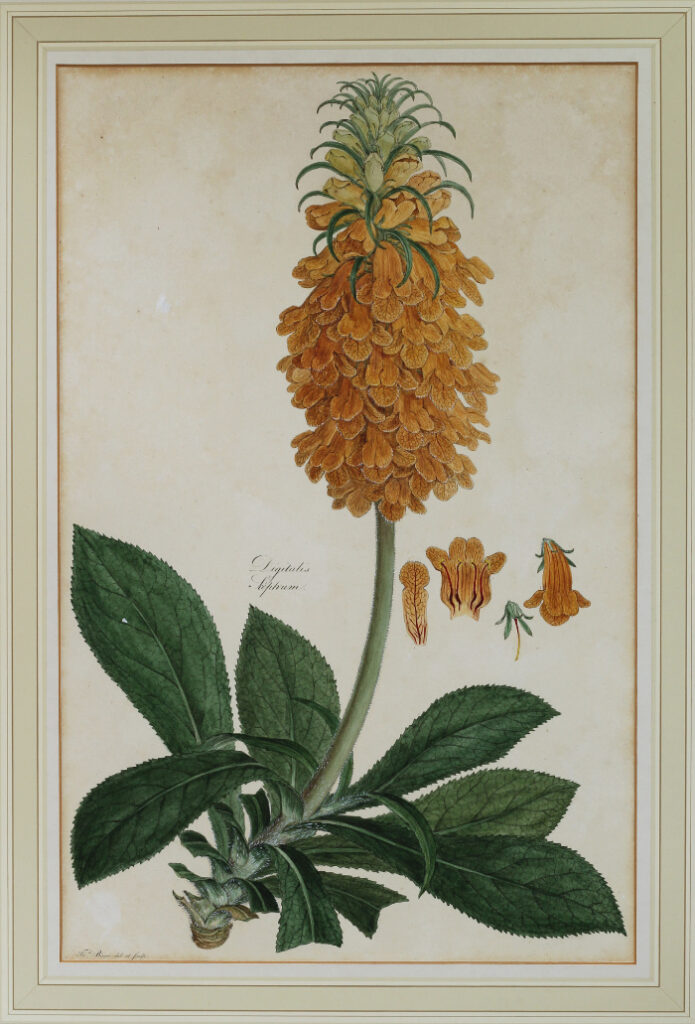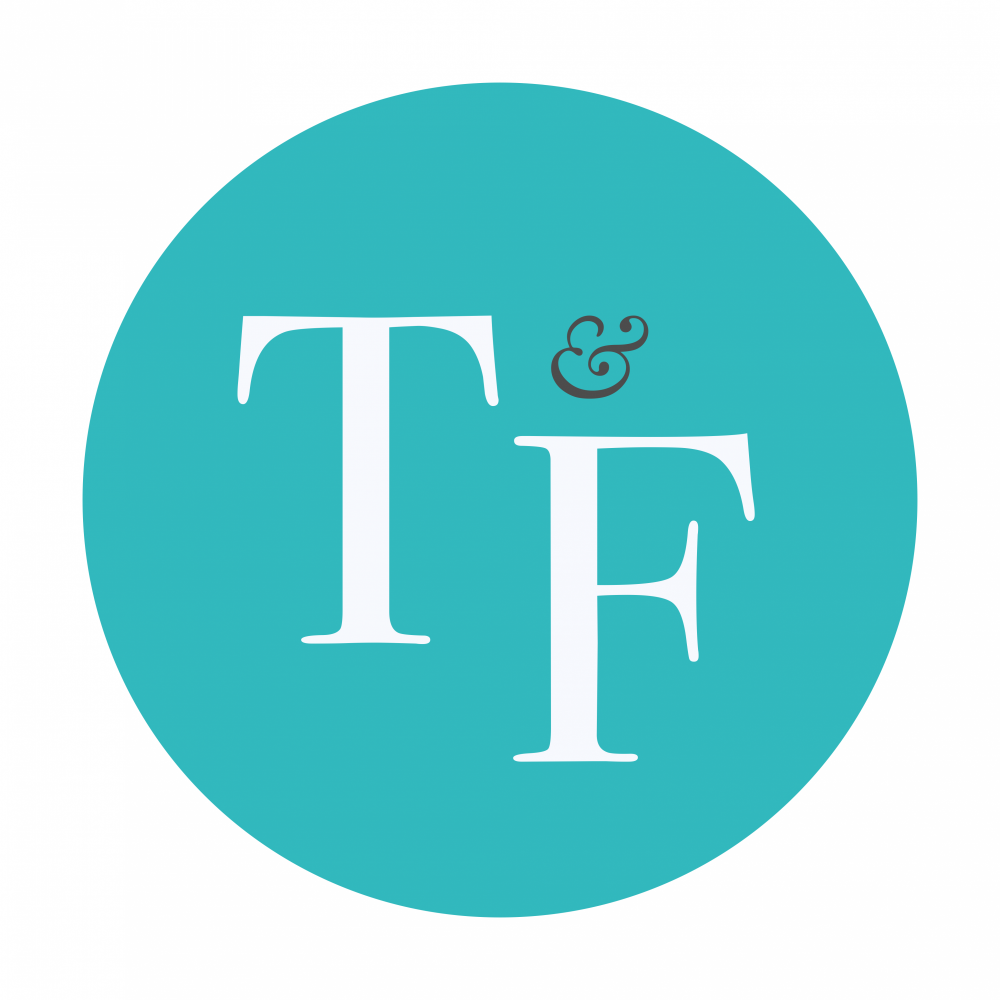A HAND-COLOURED ENGRAVED PLATE OF THE SCEPTRE FOXGLOVE BY FERDINAND BAUER, DRAWN AND ENGRAVED TO ILLUSTRATE JOHN LINDLEY’S RARE DIGITALIUM MONOGRAPHIA
BAUER, Ferdinand Lukas (artist and engraver). ‘Digitalis Sceptrum’ [i.e. Isoplexis Sceptrum. Scrophulariaceae]. [London: J.H. Bohte, 1821].
Hand-coloured engraved plate on wove paper (platemark: 388 x 247mm; sheet: 400 x 250mm). (Some light browning, especially towards margins, historic conservation of two small marks and thinning paper with white paint, including some additional heightening of the engraving, some light marking.) Tipped onto a late-20th-century mount, framed and glazed by Aram Picture Framing, London. Provenance: ‘Lindley Digitalis 28’ (late-19th-/early-20th-century pencil note in top right corner, outside of platemark) – Robert Brinsley Burbidge (1943-2019, vide infra). Exhibited: The Scottish Arts Council ‘Botanical Illustrations’ (printed exhibition object label on back of frame, recording that it was the property of Burbidge; vide infra).

Born in Austria to Lucas Bauer, court painter to the prince of Liechtenstein, Ferdinand Lukas Bauer (1760-1826) received his early artistic influences from Prior Norbert Boccius at the monastery near Feldsberg. Upon moving to Vienna at about the age of twenty with his brother Franz Andreas (who would later be Sir Joseph Banks’s first resident artist at the Royal Botanic Gardens at Kew), Ferdinand made the acquaintance of Baron Nickolaus von Jacquin, whom he helped prepare his Icones plantarum rariorum (1781-1793), and through him met John Sibthorp, to whose Flora Graeca (1806-1840) he would contribute illustrations following travels with Sibthorp to Italy, the Aegean, Turkey, Greece, and Cyprus. Indeed, in his introduction to the exhibition catalogue From Sowerby, Bauer, Hooker, and Fitch: Botanical Illustrations 1800 toPresent Day (Edinburgh, [1975]), Brinsley Burbidge explains that Ferdinand Bauer ‘was Sibthorp’s “camera” and during the year and a half they travelled together he produced some 1500 paintings including 1000 of plants often executed under very difficult conditions (and at speed) in the field’ (p. [3]). Sir Joseph Banks became aware of Ferdinand Bauer’s work through his illustrations for the Transactions of the Linnean Society and recruited him as an artist for Matthew Flinders’s expedition to Australia on HMS Investigator. During the following four years, Bauer worked alongside William Westall under the expedition’s naturalist Robert Brown, before Bauer and Brown returned to England on Investigator in 1805. Bauer returned ‘with over 2,000 illustrations in his portfolio’ (loc. cit.), from which he finished around 234 watercolours between 1806 and 1814 in London, and he also engraved seventeen of these drawings for his only publication, Illustrationes Florae Novae Hollandiae (London, 1813-1816).
The botanist and horticulturist John Lindley (1799-1865), the first professor of botany at the University of London, started his life as a plant enthusiast and, due to his family’s modest financial background, worked as a seed merchant. His friendship with the botanist and botanical illustrator William Jackson Hooker not only gave Lindley the opportunity to complete his first publication, Observations on the Structure of Fruits and Seeds (1819), but also led to an introduction to Charles Lyell, Robert Brown, and (via the latter), Sir Joseph Banks, who in 1819 employed Lindley in his library and herbarium at Soho Square as Brown’s assistant. It was in this context that Lindley researched foxgloves and undertook preliminary work on his Digitalium Monographia, which was published by J.H. Bohte in 1821.
This plate of the sceptre foxglove, then known by its Linnean binomial, Digitalis Sceptrum, was drawn and engraved by the botanical artist Ferdinand Lukas Bauer (1760-1826) for Digitalium Monographia. Bauer contributed the bulk of the 28 hand-coloured engraved plates which illustrate the work, while five were prepared by Lindley himself, and one by Ferdinand’s brother Franz. ‘By 1835 Lindley had reconsidered his classification, and proposed removing some Digitalisspecies into the new genus Isoplexis; this became one of them. It had been discovered in Madeira by Francis Masson, who sent it to Kew in 1777; it was introduced into cultivation by the Hammersmith nursery of Lee and Kennedy’ (Treasures of the Royal Horticultural Society, p. 72). The Royal Horticultural Society’s online catalogue notes that ‘[t]here are some indications that Bauer may have drawn, and even engraved, some of the plates in the 1790s’, and the original drawing for the Digitalis Sceptrum was acquired (as part of the Lindley Library) by the Royal Horticultural Society in 1866, where it is now held together with Lindley’s own copy of Digitalium Monographia.
Digitalium Monographia is a rare work (Anglo-American auction records only list two copies at auction since 1997), and this hand-coloured engraving was formerly in the collection of the botanist, historian of natural history, and photographer Robert Brinsley Burbidge PhD, FRPS. Burbidge was born in Stamford and received his undergraduate education at the University of St Andrews before studying for a doctorate at Edinburgh University. Following a position at the Royal Botanic Garden Edinburgh, Burbidge was appointed head of the Department of Information and Education at the Royal Botanic Gardens, Kew – of which Banks had effectively been Director – where he met Shirley Sherwood, whom he advised on her celebrated collection of botanical art. In the last decade of the twentieth century Burbidge moved to the United States to take up the position of Director of the Fairchild Tropical Botanic Garden in Florida, which he left on his appointment as Director of the Denver Botanic Garden, Colorado in 1999. This was followed by the position of Director of St. George Village Botanical Gardens, US Virgin Islands and, finally, the management of the landscape of a private island near St Thomas, undertaken in partnership with his wife, the gardener and artist Julie Loquidis.
According to a Scottish Arts Council printed label on the back of the frame, this engraving was loaned by Burbidge to an exhibition of ‘Botanical Illustrations’, and it seems most probable that this was ‘From Sowerby, Bauer, Hooker, and Fitch: Botanical Illustrations 1800 to Present Day’, which opened in Edinburgh, where it remained on display until 18 May 1975, before travelling to Glasgow Art Gallery and Museum (7 June-13 July 1975), Aberdeen Art Gallery and Museum (19 July-10 August 1975), and Dundee Art Gallery and Museum, (16 August-7 September 1975). While Bauer’s original watercolour for the engraving is listed in the accompanying publication From Sowerby, Bauer, Hooker, and Fitch: Botanical Illustrations 1800 to Present Day as item no. 36 (and was almost certainly exhibited in Edinburgh), it seems likely that this engraving replaced the original watercolour for the travelling exhibition, possible due to the terms of the loan from the Royal Horticultural Society. In his introduction to the exhibition catalogue, Burbidge discussed the botanical and artistic merits of the objects in the exhibition, concluding that ‘without a detailed knowledge of the structure and function of the flowers, many superficially accurate paintings may be scientifically worthless. The precise number and positions of the parts of a plant may be unimportant or may be critical: the illustrator must be aware of this and frequently will dissect a flower to give further information to the scientist. It is a peculiar art with an almost total subjegation [sic] of creativity to the accurate likeness, but some painters have transcended the limitations of their art and have given their patrons and employers more than the specific likeness for which they have been asked: they have produced, to use an unfashionable expression, works of art’ (p. [5]). Robert Weale reviewed the exhibition in the New Scientist and found it ‘well attended’, ‘[a]ssisted – perhaps even spurred – by Dr Brinsley Burbidge, the learned director of the Edinburgh Botanic Gardens’ (New Scientist 22 (22 May 1975), p. 469).
Brent Elliott, Treasures of the Royal Horticultural Society (London, 1994), p. 72.
£495
· · · · · · · · · · · · · · · · · · · · · · · · · ·
Our Terms & Conditions apply.

![Ferdinand Lukas Bauer: ‘Digitalis Sceptrum’, [1821]. £495](https://www.typeandforme.com/wp-content/uploads/2023/10/cropped-Bookflip2.jpeg)